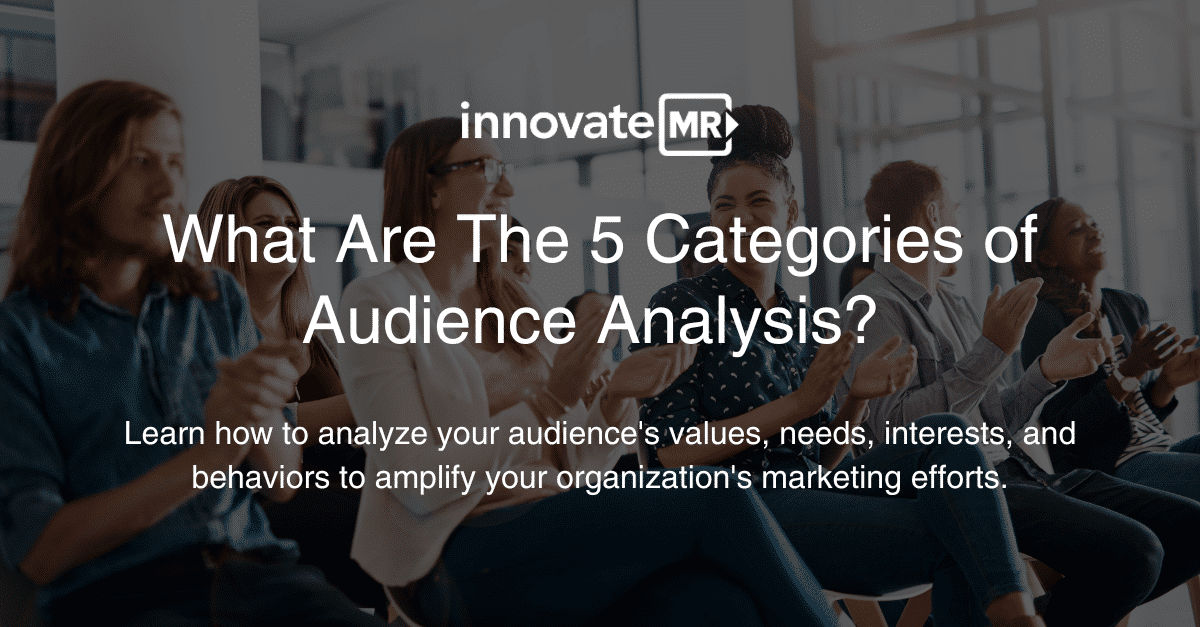
What is Audience Analysis, and Why is it Important?
The process of audience analysis consists of identifying the values, needs, interests, and behaviors of your target audience. Conducting audience analysis empowers organizations because it helps ascertain what their target audience genuinely cares deeply about. Knowing what drives a target audience allows businesses to tailor campaigns to align with their tested mission and vision, enabling them to better serve their intended consumer base. Let’s learn more about the five categories of audience analysis.

Key Categories of Audience Analysis
To conduct an effective audience analysis, it’s essential to explore the following five categories:
1. Demographic Analysis: Who Are Your Audience Members?
Demographic analysis focuses on quantifiable characteristics, such as age, gender, race, culture, ethnicity, marital status, socioeconomic status, education, and occupation. Understanding these elements allows you to target your marketing efforts effectively. For example, if launching a new alcoholic beverage, knowing the legal drinking age in your target demographic is critical.
With the rise of data analytics tools, organizations can access real-time demographic insights to inform marketing strategies and improve campaign precision to their sample target audience.
2. Psychographic Analysis: What Are Their Attitudes and Values?
Psychographic analysis delves into the attitudes, values, and beliefs of your audience. Understanding how your audience thinks and what they feel about your brand helps you craft messages that resonate. Questions to consider include: What are their opinions about your product? What stereotypes do they hold? By addressing these questions, you can tailor your messaging to align with your audience’s value systems.
Psychographic insights significantly enhance engagement and ROI, enabling you to connect with your audience on a deeper level. Brands like Nike exemplify this by aligning their messaging with the values of empowerment and self-expression.
3. Behavioral Analysis: How Do They Behave?
Behavioral analysis examines how your audience interacts with products and services, focusing on purchasing habits, usage patterns, and loyalty levels. Understanding these behaviors allows organizations to create personalized marketing strategies that cater to their audience’s preferences. For instance, consumers who frequent coffee shops may respond positively to loyalty rewards, while those who prefer brewing coffee at home may not.
Leveraging machine learning algorithms can further enhance behavioral analysis, providing insights that predict customer behavior based on past interactions.
4. Geographic Analysis: Where Are They Located?
Geographic analysis helps you understand the physical location of your audience, which can influence buying habits and preferences. For example, a surfboard company would likely succeed in marketing to coastal residents rather than individuals in landlocked areas.
Geographic information systems (GIS) offer tools for visualizing geographic data, enabling businesses to tailor their marketing strategies based on regional trends and preferences.
5. Cultural Analysis: Who Are They?
Cultural analysis involves understanding the diverse backgrounds and cultural influences that shape your audience’s beliefs and behaviors. This analysis is critical for creating messaging that is inclusive and resonates with various cultural narratives. Brands that successfully incorporate cultural analysis into their marketing, such as Coca-Cola, demonstrate a commitment to diversity and relatability in their campaigns.
Practical Tips for Effective Audience Analysis
To enhance your audience analysis efforts, consider the following practical tips:
Identify Your Audience: Clearly define your target audience by analyzing traits such as age, gender, education, occupation, cultural background, interests, and beliefs.
Conduct Comprehensive Research: Gather insights about your audience through various methods, including surveys, interviews, focus groups, and observational studies.
Analyze Your Findings: Identify common themes and patterns from your research to uncover motivations, interests, and priorities. Use these insights to tailor your messaging.
Customize Your Messaging: Use the insights gained from your analysis to adjust your messaging tone, delivery, and language to best suit your audience’s preferences.
Test Your Messages: Whenever possible, conduct message testing with a small audience segment to identify areas for improvement before launching your campaign publicly.
Common Pitfalls to Avoid in Audience Analysis
To ensure your audience analysis is effective, be mindful of the following common mistakes, along with suggested solutions:
Making Assumptions: void jumping to conclusions about your audience. Conduct thorough research to support your findings.
Solution: Conduct thorough research before reaching conclusions. Utilize diverse research methods such as surveys, interviews, and focus groups to gather a well-rounded understanding of your audience. For example, instead of assuming what your audience values, ask them directly through surveys that explore their preferences.
Narrow Focus: Consider a wide range of factors that may influence audience perception. A narrow focus on one or two demographics can limit your insights.
Solution: Take a holistic approach to audience analysis by considering multiple factors. Use segmentation tools to analyze various audience characteristics beyond age or income. For instance, segmenting your audience based on behaviors, interests, and geographic locations can yield a more comprehensive understanding.
Neglecting Diversity: Acknowledge the diversity within your audience. Incorporate inclusive strategies that cater to different preferences and backgrounds.
Solution: Incorporate diversity and inclusion into your surveys and analysis by recognizing different cultural backgrounds and perspectives. Conduct focus groups that include a diverse range of participants to gain insights into various viewpoints. For example, creating campaigns that represent multiple cultural narratives will resonate better with a wider audience.
Ignoring Feedback: Value audience feedback as it provides critical insights for refining your messaging and strategies.
Solution: Implement feedback mechanisms to gather insights from your audience continuously. Use tools like social media polls or customer feedback forms to collect opinions on your messaging and products. For example, engaging with customers on social media platforms can provide real-time feedback that informs your strategies.

Lack of Flexibility: Stay adaptable to changes in audience needs and preferences, continuously adjusting your messaging to meet evolving demands.
Solution: Establish a framework for regularly revisiting and updating your audience analysis. Stay attuned to changes in audience preferences and market trends by conducting periodic reviews and surveys. For instance, setting up a quarterly review process can help your organization remain agile and responsive to evolving audience needs.
Conclusion
Audience analysis is a powerful tool that can significantly enhance your marketing efforts. By thoroughly understanding your audience’s values, needs, interests, and behaviors, you can develop targeted campaigns that resonate deeply. Incorporating the five categories of audience analysis—demographics, psychographics, behaviors, geography, and culture—will empower your organization to connect meaningfully with consumers.
As you embark on your next research project, remember to leverage the insights from audience analysis. This foundational work will improve engagement, increase customer satisfaction, and ultimately drive better results for your organization. Embrace the power of audience analysis to create impactful marketing strategies that truly resonate with your target audience. Visit our homepage to discover how we can help you harness these insights for your success!
About InnovateMR – InnovateMR is a full-service sampling and ResTech company that delivers faster, quality insights from business and consumer audiences utilizing cutting-edge technologies to support agile research. As industry pioneers, InnovateMR provides world-class end-to-end survey programming, targeted international sampling, qualitative and quantitative insights, and customized consultation services to support informed, data-driven strategies, and identify growth opportunities. Known for their celebrated status in customer service and results, InnovateMR combines boutique-level service with extensive global reach to achieve partner success.


